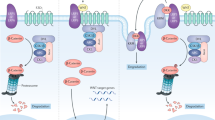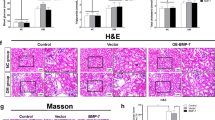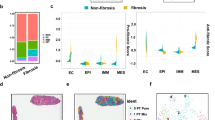Abstract
Bone morphogenic protein (BMP)-7 is a 35-kDa homodimeric protein and a member of the transforming growth factor (TGF)-β superfamily1. BMP-7 expression is highest in the kidney, and its genetic deletion in mice leads to severe impairment of eye, skeletal and kidney development2. Here we report that BMP-7 reverses TGF-β1–induced epithelial-to-mesenchymal transition (EMT) by reinduction of E-cadherin, a key epithelial cell adhesion molecule3. Additionally, we provide molecular evidence for Smad-dependent reversal of TGF-β1–induced EMT by BMP-7 in renal tubular epithelial cells and mammary ductal epithelial cells. In the kidney, EMT-induced accumulation of myofibroblasts and subsequent tubular atrophy are considered key determinants of renal fibrosis during chronic renal injury. We therefore tested the potential of BMP-7 to reverse TGF-β1–induced de novo EMT in a mouse model of chronic renal injury4. Our results show that systemic administration of recombinant human BMP-7 leads to repair of severely damaged renal tubular epithelial cells, in association with reversal of chronic renal injury. Collectively, these results provide evidence of cross talk between BMP-7 and TGF-β1 in the regulation of EMT in health and disease.
This is a preview of subscription content, access via your institution
Access options
Subscribe to this journal
Receive 12 print issues and online access
We are sorry, but there is no personal subscription option available for your country.
Buy this article
- Purchase on SpringerLink
- Instant access to full article PDF
Prices may be subject to local taxes which are calculated during checkout




Similar content being viewed by others
References
Ozkaynak, E. et al. OP-1 cDNA encodes an osteogenic protein in the TGF-beta family. EMBO J. 9, 2085–2093 (1990).
Hogan, B.L. Bone morphogenetic proteins in development. Curr. Opin. Genet. Dev. 6, 432–438 (1996).
Cano, A. et al. The transcription factor snail controls epithelial-mesenchymal transitions by repressing E-cadherin expression. Nat. Cell Biol. 2, 76–83 (2000).
Iwano, M. et al. Evidence that fibroblasts derive from epithelium during tissue fibrosis. J. Clin. Invest. 110, 341–350 (2002).
Thiery, J.P. Epithelial-mesenchymal transitions in tumor progression. Nat. Rev. Cancer 2, 442–454 (2002).
Hay, E.D. & Zuk, A. Transformations between epithelium and mesenchyme: normal, pathological, and experimentally induced. Am. J. Kidney Dis. 26, 678–690 (1995).
Strutz, F. et al. Role of basic fibroblast growth factor-2 in epithelial-mesenchymal transformation. Kidney Int. 61, 1714–1728 (2002).
Behrens, J., Lowrick, O., Klein-Hitpass, L. & Birchmeier, W. The E-cadherin promoter: functional analysis of a G.C-rich region and an epithelial cell-specific palindromic regulatory element. Proc. Natl. Acad. Sci. USA 88, 11495–11499 (1991).
Heldin, C.H., Miyazono, K. & ten Dijke, P. TGF-beta signalling from cell membrane to nucleus through SMAD proteins. Nature 390, 465–471 (1997).
Wrana, J.L. Regulation of Smad activity. Cell 100, 189–192 (2000).
Derynck, R., Zhang, Y. & Feng, X.H. Smads: transcriptional activators of TGF-beta responses. Cell 95, 737–740 (1998).
Massague, J. How cells read TGF-beta signals. Nat. Rev. Mol. Cell. Biol. 1, 169–178 (2000).
Attisano, L. & Wrana, J.L. Signal transduction by the TGF-beta superfamily. Science 296, 1646–1647 (2002).
Chen, Y.G. et al. Determinants of specificity in TGF-beta signal transduction. Genes Dev. 12, 2144–2152 (1998).
Ishida, W. et al. Smad6 is a Smad1/5-induced smad inhibitor. Characterization of bone morphogenetic protein-responsive element in the mouse Smad6 promoter. J. Biol. Chem. 275, 6075–6079 (2000).
Candia, A.F. et al. Cellular interpretation of multiple TGF-beta signals: intracellular antagonism between activin/BVg1 and BMP-2/4 signaling mediated by Smads. Development 124, 4467–4480 (1997).
Comijn, J. et al. The two-handed E box binding zinc finger protein SIP1 downregulates E- cadherin and induces invasion. Mol. Cell 7, 1267–1278 (2001).
Lloyd, C.M. et al. RANTES and monocyte chemoattractant protein-1 (MCP-1) play an important role in the inflammatory phase of crescentic nephritis, but only MCP-1 is involved in crescent formation and interstitial fibrosis. J. Exp. Med. 185, 1371–1380 (1997).
Hruska, K.A. et al. Osteogenic protein-1 prevents renal fibrogenesis associated with ureteral obstruction. Am. J. Physiol. Renal Physiol. 279, F130–F143 (2000).
Border, W.A. et al. Natural inhibitor of transforming growth factor-beta protects against scarring in experimental kidney disease. Nature 360, 361–364 (1992).
Remuzzi, G. & Bertani, T. Pathophysiology of progressive nephropathies. N. Engl. J. Med. 339, 1448–1456 (1998).
Hennig, G., Lowrick, O., Birchmeier, W. & Behrens, J. Mechanisms identified in the transcriptional control of epithelial gene expression. J. Biol. Chem. 271, 595–602 (1996).
Kawabata, M., Inoue, H., Hanyu, A., Imamura, T. & Miyazono, K. Smad proteins exist as monomers in vivo and undergo homo- and hetero- oligomerization upon activation by serine/threonine kinase receptors. EMBO J. 17, 4056–4065 (1998).
Imamura, T. et al. Smad6 inhibits signalling by the TGF-beta superfamily. Nature 389, 622–626 (1997).
Okada, H., Danoff, T.M., Kalluri, R. & Neilson, E.G. Early role of Fsp1 in epithelial-mesenchymal transformation. Am. J. Physiol. 273, F563–F574 (1997).
Zeisberg, M. et al. Renal fibrosis: collagen composition and assembly regulates epithelial-mesenchymal transdifferentiation. Am. J. Pathol. 159, 1313–1321 (2001).
Hanai, J. et al. Interaction and functional cooperation of PEBP2/CBF with Smads. Synergistic induction of the immunoglobulin germline C alpha promoter. J. Biol. Chem. 274, 31577–31582 (1999).
Zeisberg, M., Maeshima, Y., Mosterman, B. & Kalluri, R. Renal fibrosis: extracellular matrix microenvironment regulates migratory behavior of activated tubular epithelial cells. Am. J. Pathol. 160, 2001–2008 (2002).
Acknowledgements
This study was supported by National Institutes of Health grants DK 51711, DK 55001, T32 DK07199-25, Deutsche Forschungsgemeinschaft grant DFG ZE523/1-1 (to M.Z.) and Beth Israel Deaconess Medical Center funds associated with the Center for Matrix Biology. We thank Creative Biomolecules/Curis, Inc. for the recombinant human BMP-7; V.P. Sukhatme for introducing us to Creative Biomolecules/Curis, Inc. when he served as their consultant; and L. Siniski and A. Zuk for their help with the preparation of this manuscript; F.S. was a visiting scientist at Beth Israel Deaconess Medical Center and Harvard Medical School during the course of this study.
Author information
Authors and Affiliations
Corresponding author
Ethics declarations
Competing interests
The authors declare no competing financial interests.
Supplementary information
Rights and permissions
About this article
Cite this article
Zeisberg, M., Hanai, Ji., Sugimoto, H. et al. BMP-7 counteracts TGF-β1–induced epithelial-to-mesenchymal transition and reverses chronic renal injury. Nat Med 9, 964–968 (2003). https://doi.org/10.1038/nm888
Received:
Accepted:
Published:
Issue Date:
DOI: https://doi.org/10.1038/nm888



